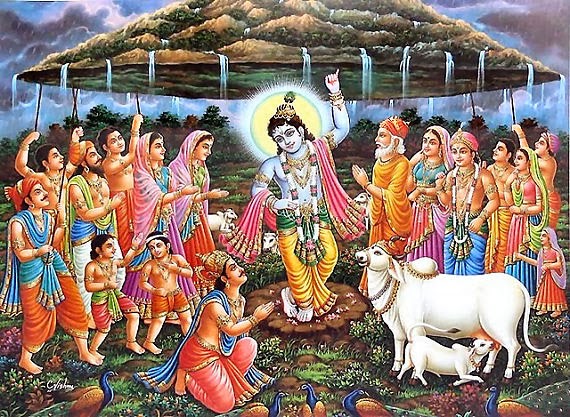Most Hindus are familiar with the well-known katha of Shri Krishna and Mount Goverdhan. In this divine leela, Shri Krishna shields the villagers of Vraj from heavy rains by uplifting Mount Goverdhan with the little finger of his left hand and sheltering them. He is known as Goverdhan Giridhaari, who championed the cause of his devotees. We celebrate this katha on the day after Divali with Goverdhan puja.
Shri Krishna revealed that the Divine Brahm can assume any form. As Sri Krishna, Bhagavan encouraged the villagers to worship the divine form of Goverdhan. He also strengthened their belief by appearing from the mountain in another divine form who accepted the devotees’ offerings. In the Bhagavad Gita (Ch. 9, verse 26), Shri Krishna says, “Whenever a devotee of purified intellect offers to me, with love, a leaf, a flower, a fruit or water, I personally appear before that devotee and delightfully partake of that offering.” These simple devotees had pure love for Shri Krishna and the Lord appeared to them and accepted their offerings.
It is said that when the Lord manifests, he functions in two ways: tatastha lakshan where he acts as a man among men and svarupa lakshan, where he acts with his true divine qualities. That is, there are times when divinity’s true essence is revealed and there are times when the very same divinity, embodied, behaves as a human. When Shri Raam and Shri Krishna destroyed the demonic forces, svarupa lakshan was at work. In this katha, He behaves like an ordinary child, questioning his parents about the reason for the village festivities, and He then reveals his essential superhuman divinity by lifting the mountain.
This katha has deep metaphysical implications that apply to each of us. To understand the inner meaning of this katha, we must understand that Goverdhan represents the mountain of yoga, of mental and spiritual advancement. If we analyse the word, Goverdhan, ‘go’ means ‘senses’, ‘var’ means a ‘boon’, ‘dhan’ is ‘wealth’. If I have the gift of control over the senses, then I have spiritual wealth. Shri Krishna is the foundation of yoga; he is a Mahayogi. Lifting the inner mountain means lifting our understanding of the eternal principles that reside within the body.
However, that mountain is often deluged by the waters of the senses when they are concentrated upon the world. To advance spiritually, we must transcend the gross senses. This mountain of yoga, union with God, is in each of us. The ultimate objective of all religious sacrifices is for atma (the individual soul) to join Paramatma (the Divine Soul). By genuine performance of rituals together with an understanding of their inner significance, we can lift ourselves up spiritually.
The five fingers on each hand are symbolic: the thumb symbolises Brahm; the index finger is jiva, the individual soul; the middle finger represents sattvic prakriti (the state of piety and righteousness); the ring finger is rajasic prakriti (the state of activity and materialism) and the small finger, tamas prakriti (the state of non-differentiation and quietude). Yogis place their fingers in various positions called mudras. For example, the index finger together with the thumb and the other three fingers extended is a significant mudra that symbolises transcending the three gunas (modes of existence) and jiva (the individual soul) merging with Brahm. Tamas prakriti is the state of oneness and stillness. The mountain of mental advancement cannot be uplifted when the mind is in the materialistic mode. The mind and body must be stabilised in tamas prakriti.
The mountain (parvat) also means ‘spine’. In each of us in the subtle body, there are channels of bioenergy: Ida Naadi, the Pingala Naadi and the Sushumna Naadi. These correspond to the actual Ganga and Jamuna rivers and Saraswati, the subterranean stream. These channels of bioenergy merge at the ajna chakra, located in the forehead, that corresponds to the Indian Triveni confluence of rivers. There are seven major chakras that reside in the subtle body that can be activated in order to awaken Kundalini Shakti (the spiritual power lying dormant at the base of the spine).
All the organs in the body correspond to the various Devtas. The sun, the moon, Brahma, Vishnu and Shiva, all reside inside us. Brahm is within in the form of atma, the soul. Bhagavan Shri Krishna in the Bhagavad Gita, Chapter 13, says, “I am the soul in each person.” The senses, indriyas, must be turned inward so that we can tap into our divinity. This is the universal meaning of Goverdhan puja. When Goverdhan is worshipped, the intellect is purified; the senses rise beyond the waters of sensuality and the mountain of yoga is lifted. Shri Krishna katha reminds us that the journey must be inward. Go inside and discover the eternal truths that exist. Understand the secrets of the universe by understanding the human body. Let us pray that Shri Krishna uplift Mount Goverdhan in each of us.



